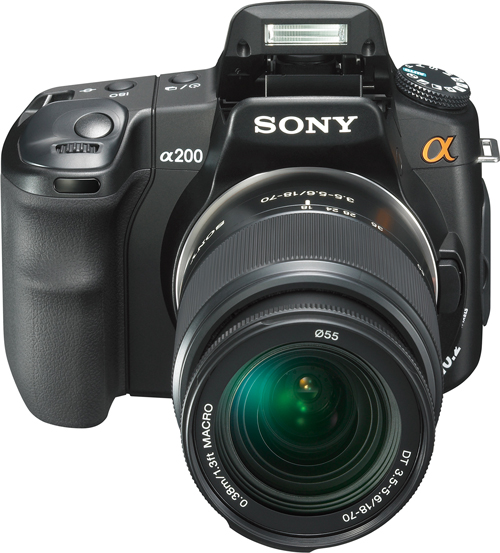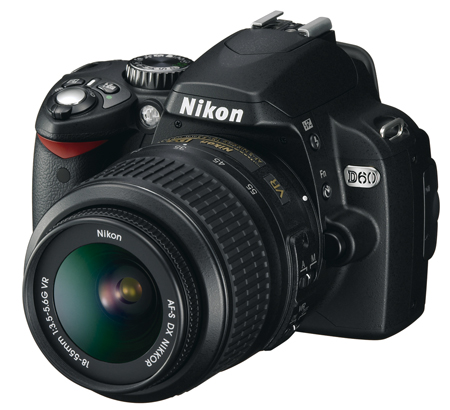Sony A200: Entry DSLR Roundup
by Wesley Fink on October 20, 2008 1:00 AM EST- Posted in
- Digital Camera
With all the press and excitement in the past few weeks over $3000 full-frame Digital SLR cameras, it is easy to forget that many buyers are looking for the absolute best "bang-for-the-buck" in a camera. There is little doubt that you will find that best value today in interchangeable lens DSLRs that now offer almost all of today's checklist features starting at a $499 street price.

So what do you get for your $500 these days? To answer that question we took a closer look at Sony's lowest-priced DSLR. The Sony A200 sells complete with a Sony 18-70mm (27 to 105mm equivalent) lens for just $499 - sometimes even less. The A200 also features body-integral image stabilization, which means the IS will work with any lens you mount. Sony does not include Live View in the A200, choosing instead to feature Live View only on the A300/A350, which use a uniquely easy to use and useful Live View compared to competing models.

The only competition in the $500 arena is the Olympus E420 which sells for around $530 with the 14-42mm (28-84mm equivalent), and the recently reduced Canon XS with a current street price of around $525 with an Optical IS 18-55mm lens. The E420 is the smallest mirror DSLR on the market. However, it is now the only camera in its class to not offer some form of IS - either in the camera body or by including a kit lens with IS or VR built-in. You will have to move up to the E520 at $100 more for IS in the body. The E420 does feature Live View, a feature pioneered by Olympus, including both phase-detect and contrast-detect options. The Canon XS also includes both Live View options.


The DSLR "entry" market also includes the next rung at a $599 street price with lens. This adds the Nikon D60, Olympus E520, Pentax K200D, and Sony A300. All five sell for a street price of $599 with an 18-55mm or equivalent kit lens (18-70mm for the A300). The Pentax, Olympus, and Sony feature body-integral IS that works with any lens and the Canon and Nikon kits include a stabilized kit lens, but still require IS or VR lenses for the IS feature.

Clearly this has become a very crowded market segment, which is great news for buyers. In the $499 to $599 price range you now have a choice of no less than seven models from the top five DSLR manufacturers. With such a wide selection there are a lot of models competing for your attention and that can lead to even better prices. Today we will take a closer look at the Sony A200, which is arguably the lowest priced "full-featured" DSLR you can buy today. Does this price-leader also bring true value to the DSLR market?










32 Comments
View All Comments
JarredWalton - Monday, October 20, 2008 - link
I think particularly in the entry level DSLR arena, using the included lenses for images is important. The pictures of even a moderate DSLR with kit lens should easily surpass what most P&S cameras can manage, which is one of the big attractions. As soon as you get into lenses, however, you open up a huge can of worms.As for the subject material... well, I'll leave it to the photography buffs to debate what should be used. I believe Wes is working on some photos showing what the A200 can do out of a static test environment, but in order to provide any semblance of apples-to-apples shooting comparisons I think you need to do something like the shots Wes uses. I know I for one wish the white balance on my XTi did better under Tungsten lighting.
nowayout99 - Monday, October 20, 2008 - link
"...it is easy to forget that many buyers are looking for the absolute best "bang-for-the-buck" in a camera."Really...? Therein lies a divide between AT and readers. Articles for high-end products really aren't appealing to that many people, yet that's almost all we've gotten for cameras.
Even this $500 cam is pretty high-end priced for the vast majority of people that just want something they can take around with them for fun. How about some comparisons of joe schmoe cameras?
strikeback03 - Tuesday, October 21, 2008 - link
On Sunday a friend and I went to a local state park to get some pictures of the leaves. He owns a Canon SD600, a relatively decent couple year old P&S. At one point he was asking me to get some close-ups of a rock face, so instead I tossed my Sigma 18-200 OS on my Rebel XT body (wasn't using either) and let him play with those. I think he is now in the market for an SLR, as some comparison shots he did with his SD600 just blew him away, and that was just in basic JPEG mode.GTVic - Monday, October 20, 2008 - link
This is what epinions and CNET is for. I don't think you will find too many serious reviewers who want to spend their time keeping updated on the sub $200 camera market. It is not interesting, there are too many cameras to keep track of and not many people do serious research on that level of purchase.adder - Monday, October 20, 2008 - link
well i hope u guys do some lens reviews,and for people who are going in for a entry level dslr may not know much about lenses other then the kits lenses.strikeback03 - Monday, October 20, 2008 - link
Is the grip the same as the A100? Between the length and positioning of the shutter release/dial, I found the A100 quite uncomfortable to use. For me either the shorter bodies like the Canon Rebels or the taller ones like Nikon D80/Canon 40D are far more comfortable.FATCamaro - Monday, October 20, 2008 - link
It is a great point and shoot camera. I use mine a LOT and couldn't be happier. I use it as a point and shoot except for ISO and flash control. The ISO control is incredible simple and useful. I would reccomend this to to anyone switching up to a DSLR from a shitty point and shoot.DanD85 - Monday, October 20, 2008 - link
It seems you forget the still available D40/D40x and I think they perfectly fit in the budget DSLRs you have here.Wesley Fink - Monday, October 20, 2008 - link
Ken Rockwell notwithstanding, the D40 is 6 megapixels and the D40x is the previous model to the D60. Both are capable entry DSLRs that have been updated in the D60, which we did test in our comparison.The D40/D40x are 3-point AF, have no sensor cleaning, and come with non-IS kit lenses. Their features have been upgraded on the D60, which is the entry model we tested.
xsilver - Monday, October 20, 2008 - link
also forgotten is the pentax line. The k200d doesnt have live view either but using old lenses on them is a joy.